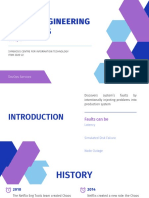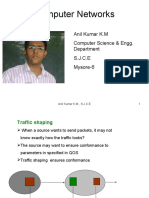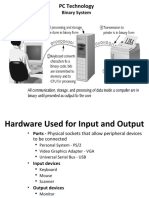Free Exam/Cram Practice Materials - Best Exam Practice Materials
IT Certification Guaranteed, The Easy Way!
NO.1 You need to create a new transaction table in Cloud Spanner that stores product sales data.
You are deciding what to use as a primary key. From a performance perspective, which strategy
should you choose?
A. The current epoch time
B. A concatenation of the product name and the current epoch time
C. A random universally unique identifier number (version 4 UUID)
D. The original order identification number from the sales system, which is a monotonically
increasing integer
Answer: C
NO.2 You want to use Google Stackdriver Logging to monitor Google BigQuery usage. You need an
instant notification to be sent to your monitoring tool when new data is appended to a certain table
using an insert job, but you do not want to receive notifications for other tables. What should you
do?
A. Make a call to the Stackdriver API to list all logs, and apply an advanced filter.
B. In the Stackdriver logging admin interface, and enable a log sink export to BigQuery.
C. In the Stackdriver logging admin interface, enable a log sink export to Google Cloud Pub/Sub, and
subscribe to the topic from your monitoring tool.
D. Using the Stackdriver API, create a project sink with advanced log filter to export to Pub/Sub, and
subscribe to the topic from your monitoring tool.
Answer: B
NO.3 An online retailer has built their current application on Google App Engine. A new initiative at
the company mandates that they extend their application to allow their customers to transact
directly via the application.
They need to manage their shopping transactions and analyze combined data from multiple datasets
using a business intelligence (BI) tool. They want to use only a single database for this purpose. Which
Google Cloud database should they choose?
A. BigQuery
B. Cloud SQL
C. Cloud BigTable
D. Cloud Datastore
Answer: C
NO.4 Your startup has never implemented a formal security policy. Currently, everyone in the
company has access to the datasets stored in Google BigQuery. Teams have freedom to use the
service as they see fit, and they have not documented their use cases. You have been asked to secure
the data warehouse. You need to discover what everyone is doing. What should you do first?
A. Use Google Stackdriver Audit Logs to review data access.
B. Get the identity and access management IIAM) policy of each table
C. Use Stackdriver Monitoring to see the usage of BigQuery query slots.
D. Use the Google Cloud Billing API to see what account the warehouse is being billed to.
Answer: A
2 from Freecram.com.
Get Latest & Valid Google Exam's Question and Answers 1
https://www.freecram.com/exam/Professional-Data-Engineer-google-cloud-certified-professional-data-engineer-exam-
e9367.html
� Free Exam/Cram Practice Materials - Best Exam Practice Materials
IT Certification Guaranteed, The Easy Way!
NO.5 You are building a new data pipeline to share data between two different types of applications:
jobs generators and job runners. Your solution must scale to accommodate increases in usage and
must accommodate the addition of new applications without negatively affecting the performance of
existing ones. What should you do?
A. Create an API using App Engine to receive and send messages to the applications
B. Use a Cloud Pub/Sub topic to publish jobs, and use subscriptions to execute them
C. Create a table on Cloud SQL, and insert and delete rows with the job information
D. Create a table on Cloud Spanner, and insert and delete rows with the job information
Answer: A
NO.6 You are developing an application on Google Cloud that will automatically generate subject
labels for users' blog posts. You are under competitive pressure to add this feature quickly, and you
have no additional developer resources. No one on your team has experience with machine learning.
What should you do?
A. Call the Cloud Natural Language API from your application. Process the generated Entity Analysis
as labels.
B. Call the Cloud Natural Language API from your application. Process the generated Sentiment
Analysis as labels.
C. Build and train a text classification model using TensorFlow. Deploy the model using Cloud
Machine Learning Engine. Call the model from your application and process the results as labels.
D. Build and train a text classification model using TensorFlow. Deploy the model using a Kubernetes
Engine cluster. Call the model from your application and process the results as labels.
Answer: A
NO.7 Flowlogistic Case Study
Company Overview
Flowlogistic is a leading logistics and supply chain provider. They help businesses throughout the
world manage their resources and transport them to their final destination. The company has grown
rapidly, expanding their offerings to include rail, truck, aircraft, and oceanic shipping.
Company Background
The company started as a regional trucking company, and then expanded into other logistics market.
Because they have not updated their infrastructure, managing and tracking orders and shipments has
become a bottleneck. To improve operations, Flowlogistic developed proprietary technology for
tracking shipments in real time at the parcel level. However, they are unable to deploy it because
their technology stack, based on Apache Kafka, cannot support the processing volume. In addition,
Flowlogistic wants to further analyze their orders and shipments to determine how best to deploy
their resources.
Solution Concept
Flowlogistic wants to implement two concepts using the cloud:
* Use their proprietary technology in a real-time inventory-tracking system that indicates the location
of their loads
* Perform analytics on all their orders and shipment logs, which contain both structured and
unstructured data, to determine how best to deploy resources, which markets to expand info. They
also want to use predictive analytics to learn earlier when a shipment will be delayed.
Existing Technical Environment
3 from Freecram.com.
Get Latest & Valid Google Exam's Question and Answers 2
https://www.freecram.com/exam/Professional-Data-Engineer-google-cloud-certified-professional-data-engineer-exam-
e9367.html
� Free Exam/Cram Practice Materials - Best Exam Practice Materials
IT Certification Guaranteed, The Easy Way!
Flowlogistic architecture resides in a single data center:
* Databases
* 8 physical servers in 2 clusters
* SQL Server - user data, inventory, static data
* 3 physical servers
* Cassandra - metadata, tracking messages
10 Kafka servers - tracking message aggregation and batch insert
* Application servers - customer front end, middleware for order/customs
* 60 virtual machines across 20 physical servers
* Tomcat - Java services
* Nginx - static content
* Batch servers
Storage appliances
* iSCSI for virtual machine (VM) hosts
* Fibre Channel storage area network (FC SAN) - SQL server storage
* Network-attached storage (NAS) image storage, logs, backups
* 10 Apache Hadoop /Spark servers
* Core Data Lake
* Data analysis workloads
* 20 miscellaneous servers
* Jenkins, monitoring, bastion hosts,
Business Requirements
* Build a reliable and reproducible environment with scaled panty of production.
* Aggregate data in a centralized Data Lake for analysis
* Use historical data to perform predictive analytics on future shipments
* Accurately track every shipment worldwide using proprietary technology
* Improve business agility and speed of innovation through rapid provisioning of new resources
* Analyze and optimize architecture for performance in the cloud
* Migrate fully to the cloud if all other requirements are met
Technical Requirements
* Handle both streaming and batch data
* Migrate existing Hadoop workloads
* Ensure architecture is scalable and elastic to meet the changing demands of the company.
* Use managed services whenever possible
* Encrypt data flight and at rest
* Connect a VPN between the production data center and cloud environment SEO Statement We
have grown so quickly that our inability to upgrade our infrastructure is really hampering further
growth and efficiency. We are efficient at moving shipments around the world, but we are inefficient
at moving data around.
We need to organize our information so we can more easily understand where our customers are
and what they are shipping.
CTO Statement
IT has never been a priority for us, so as our data has grown, we have not invested enough in our
technology. I have a good staff to manage IT, but they are so busy managing our infrastructure that I
cannot get them to do the things that really matter, such as organizing our data, building the
analytics, and figuring out how to implement the CFO' s tracking technology.
4 from Freecram.com.
Get Latest & Valid Google Exam's Question and Answers 3
https://www.freecram.com/exam/Professional-Data-Engineer-google-cloud-certified-professional-data-engineer-exam-
e9367.html
� Free Exam/Cram Practice Materials - Best Exam Practice Materials
IT Certification Guaranteed, The Easy Way!
CFO Statement
Part of our competitive advantage is that we penalize ourselves for late shipments and deliveries.
Knowing where out shipments are at all times has a direct correlation to our bottom line and
profitability. Additionally, I don't want to commit capital to building out a server environment.
Flowlogistic's CEO wants to gain rapid insight into their customer base so his sales team can be better
informed in the field. This team is not very technical, so they've purchased a visualization tool to
simplify the creation of BigQuery reports. However, they've been overwhelmed by all the data in the
table, and are spending a lot of money on queries trying to find the data they need. You want to solve
their problem in the most cost-effective way. What should you do?
A. Export the data into a Google Sheet for virtualization.
B. Create an additional table with only the necessary columns.
C. Create a view on the table to present to the virtualization tool.
D. Create identity and access management (IAM) roles on the appropriate columns, so only they
appear in a query.
Answer: C
NO.8 You store historic data in Cloud Storage. You need to perform analytics on the historic data.
You want to use a solution to detect invalid data entries and perform data transformations that will
not require programming or knowledge of SQL.
What should you do?
A. Use Cloud Dataflow with Beam to detect errors and perform transformations.
B. Use Cloud Dataprep with recipes to detect errors and perform transformations.
C. Use Cloud Dataproc with a Hadoop job to detect errors and perform transformations.
D. Use federated tables in BigQuery with queries to detect errors and perform transformations.
Answer: A
NO.9 You have a requirement to insert minute-resolution data from 50,000 sensors into a BigQuery
table. You expect significant growth in data volume and need the data to be available within 1 minute
of ingestion for real-time analysis of aggregated trends. What should you do?
A. Use bq load to load a batch of sensor data every 60 seconds.
B. Use a Cloud Dataflow pipeline to stream data into the BigQuery table.
C. Use the INSERT statement to insert a batch of data every 60 seconds.
D. Use the MERGE statement to apply updates in batch every 60 seconds.
Answer: C
NO.10 You set up a streaming data insert into a Redis cluster via a Kafka cluster. Both clusters are
running on Compute Engine instances. You need to encrypt data at rest with encryption keys that you
can create, rotate, and destroy as needed. What should you do?
A. Create a dedicated service account, and use encryption at rest to reference your data stored in
your Compute Engine cluster instances as part of your API service calls.
B. Create encryption keys in Cloud Key Management Service. Use those keys to encrypt your data in
all of the Compute Engine cluster instances.
C. Create encryption keys locally. Upload your encryption keys to Cloud Key Management Service.
Use those keys to encrypt your data in all of the Compute Engine cluster instances.
5 from Freecram.com.
Get Latest & Valid Google Exam's Question and Answers 4
https://www.freecram.com/exam/Professional-Data-Engineer-google-cloud-certified-professional-data-engineer-exam-
e9367.html
� Free Exam/Cram Practice Materials - Best Exam Practice Materials
IT Certification Guaranteed, The Easy Way!
D. Create encryption keys in Cloud Key Management Service. Reference those keys in your API
service calls when accessing the data in your Compute Engine cluster instances.
Answer: C
6 from Freecram.com.
Get Latest & Valid Google Exam's Question and Answers 5
https://www.freecram.com/exam/Professional-Data-Engineer-google-cloud-certified-professional-data-engineer-exam-
e9367.html


































































































